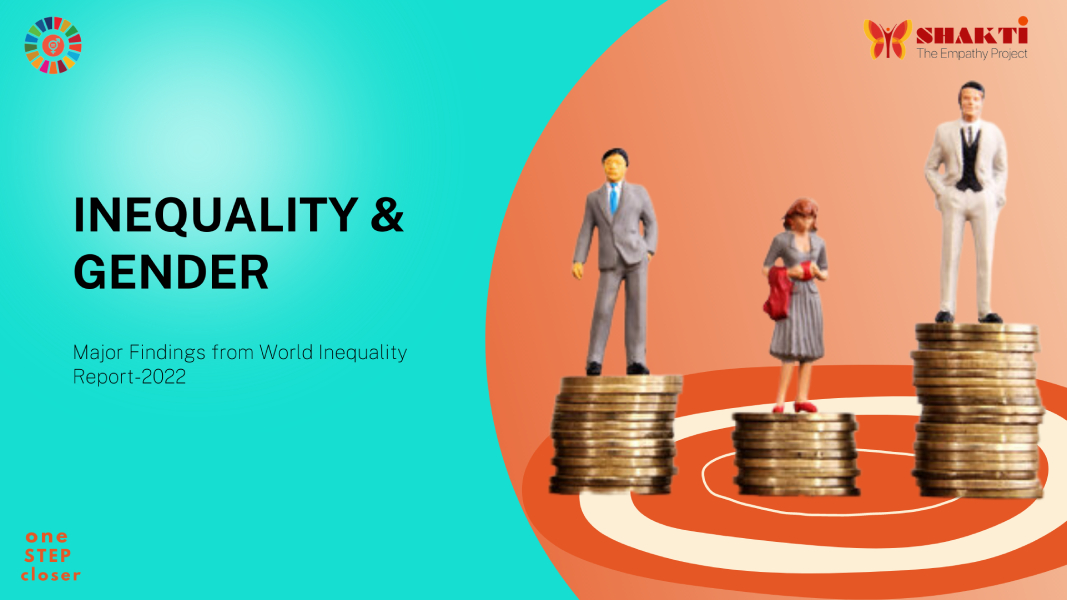Inequality and Gender: Insights from World Inequality Report, 2022
The World Inequality Lab, based in France, released the latest World Inequality Report recently, for the year 2022. This report tries to put light on the wealth, income, gender and environmental inequalities across various countries and regions around the world.
The major findings of the report were widely published in various media channels and news reports. The report notes that India is among the most unequal countries in the world and the top 1 % of India’s population owns more than one-fifth of the total national income in 2021.
In this article, we will focus on the gender aspect of the inequality covered in this report.
To better understand where the societies stand, in terms of gender inequality at work, this report has used ‘the relative overall share of labour income accruing to men and women, as a metric.
Global earnings
The World Inequality Report 2022 provides the first estimates of the gender inequality of global earnings. In a gender-equal world, women would earn 50% of all labour incomes, but at present, it is at 34%, a mere 4% increase since 1990.
How India has fared?
The female labour income share in India is 18% which is significantly lower than the average in Asia(21%, excluding China). This value is one of the lowest in the world. Even though India has seen a significant increase observed since 1990, it has been insufficient to lift women’s labour income share to the regional average.
Regional divide
The female share of labour income varies a lot across various regions of the world. This is relatively very high in Westen Europe, where the average female share is estimated at around 39%. Even the variability across countries appears to be relatively low in this region.
This value is lowest in the region of the Middle East and Northern Africa (MENA) where female gets only a 15% share of the overall labour income. One of the reasons for this is that MENA countries share religious and cultural backgrounds, with social norms that tend to hinder the participation of women in the labour market.
Impact of laws and policies
In the eastern bloc countries, most of those which were part of the former USSR, the share of female labour income is highest (41%), as most of the countries in this region shared a history of communist governments that supported the participation of women in the market through various laws and policies.
Interestingly, China which historically put a strong emphasis on gender equality and high female labour force participation performs relatively poor than its former communist peers(33%).
Evolution of Female labour income
The evolution of the female share of labour income has been strongest in the region of Latin America and Western Europe. In the region of Eastern bloc countries, the report notes that the growth appears to be stagnated in the last two decades.
In terms of evolution over time, it appears that the female share of labour income has grown in every region except China. The report mentions that the decline could be due to various factors including the downsizing of State-owned enterprises, which significantly impacted the participation of urban women in the labour force and the relaxation of the One-child policy at the end of 2013 among others.
Women hold up half the sky, only a third of income
There are various factors involved that explain gender differences in employment and earnings that results in women earning a smaller share in labour income. Among these, one of the most significant is the fact that women spend substantially more time in unpaid work than men.
Findings in this report support the above hypothesis. In MENA (the Middle East and North Africa) region, women spend on average more than five hours doing unpaid work, while men spend less than one hour. This higher load of unpaid care work is likely to prevent women from participating in the labour market, and, when they do work, to prevent them from attaining high-paying positions.
Employment and Earnings
The female share of labour income depends on two dimensions: their participation in the labour force compared to men and their earning ratio. When both of these factors are high, the female share of labour income is high as well.
In Sub-Saharan Africa, the employment ratio is significantly high (86%) while the female earning ratio is much lower, at 46%. This is because women in this region have high access to paid work but are paid much less. Compared to the MENA region which shows a relatively high female earnings ratio, but low participation rates among women. This suggests that only highly paid women are selected into the labour market there.
The glass ceiling for women income
The report suggests that the women’s representation in the top 1% of the wage bracket is much lower than their representation in the top 10%, indicating that there is a strong “glass-ceiling” effect, whereby the wage gap increases towards the top of the wage distribution, the main driver of which is the under-representation of women in top-paying positions.
One of the reasons for this is the temporal inflexibility of many high paying jobs, particularly the more than proportional reward for working long hours in executive jobs, which many women cannot do because of childcare and household duties.
Conclusion
The World Inequality Report, 2022 has pointed out that income inequalities between men and women remain particularly significant both within countries and at the world level today.
Men earn approximately twice as much as women across the world, on average.
Lessons could be learnt from various regions of the world which have performed better than the rest and the steps that they have taken to bridge this gap.



